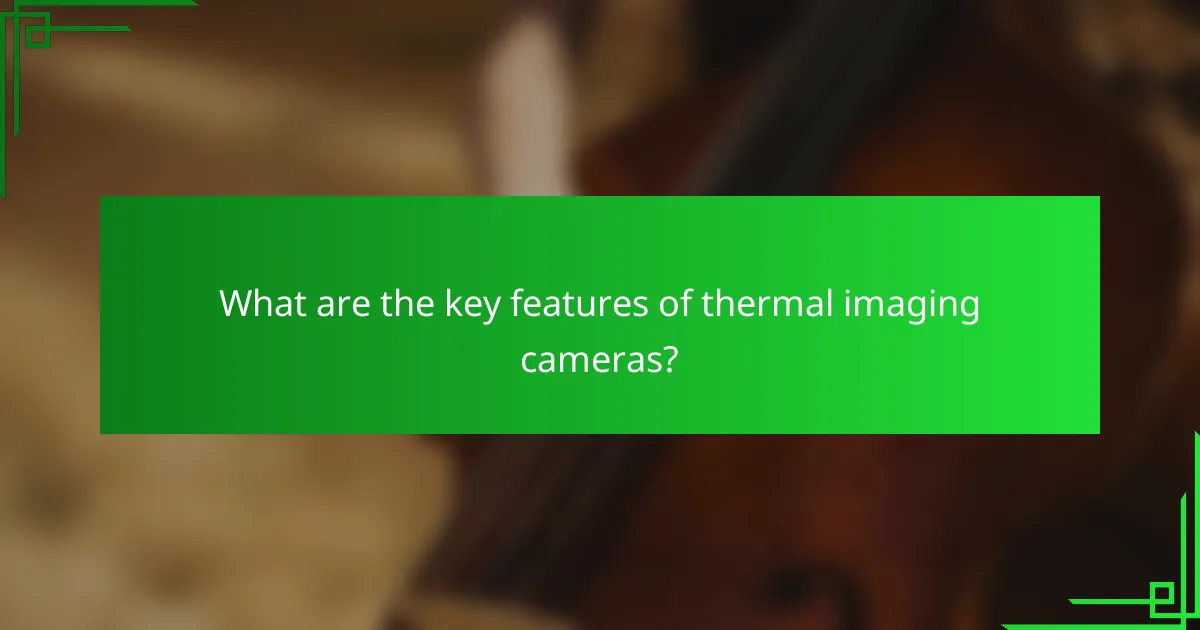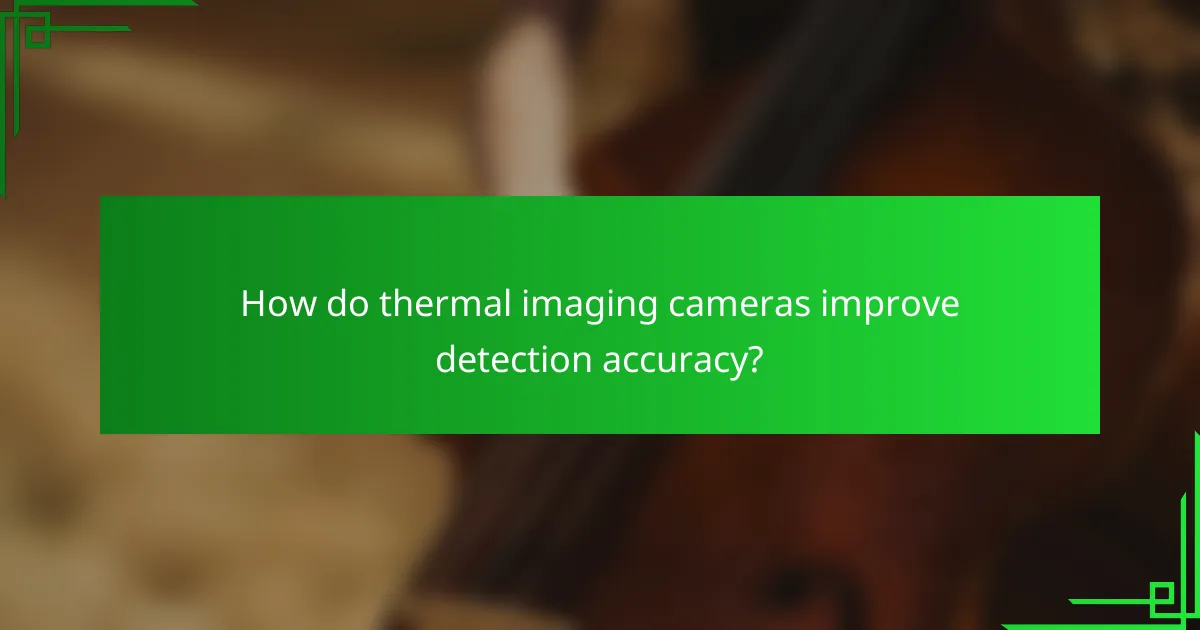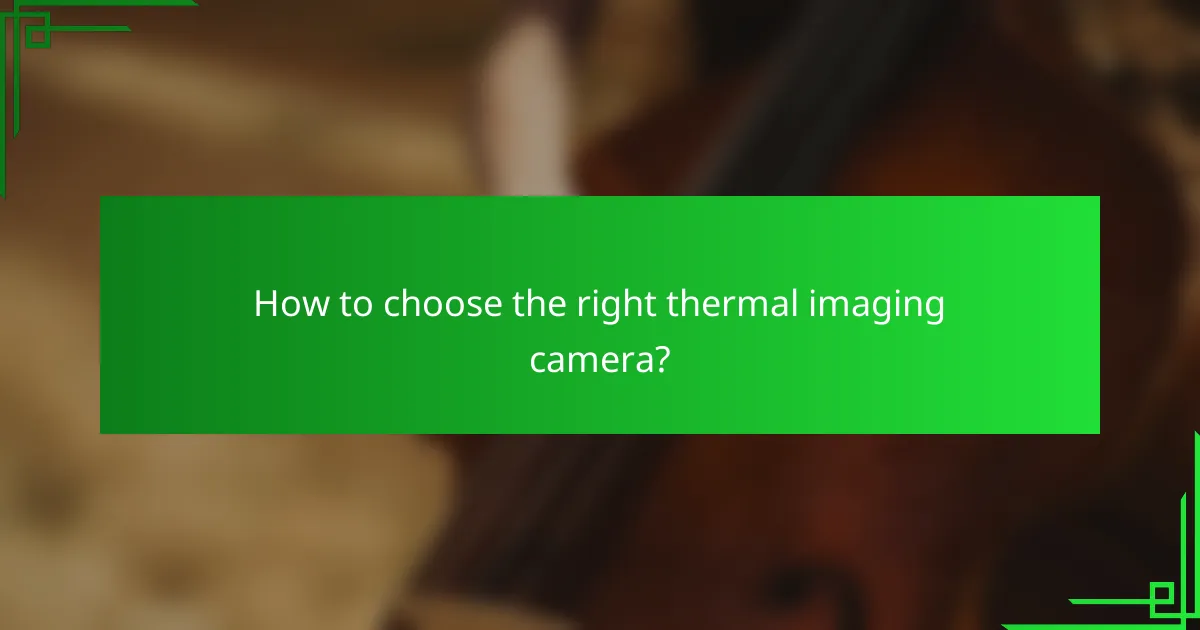Thermal imaging cameras are innovative tools that enhance visibility by detecting infrared radiation, revealing heat patterns that are not visible to the naked eye. Their ability to convert thermal energy into clear images significantly improves detection accuracy, making them invaluable in fields such as security, firefighting, and building inspections. With advanced features like image processing technology and temperature sensitivity, these cameras also provide an enhanced user experience across various applications.

How do thermal imaging cameras enhance visibility?
Thermal imaging cameras enhance visibility by detecting infrared radiation emitted by objects, allowing users to see heat patterns that are invisible to the naked eye. This capability is crucial in various applications, including security, firefighting, and building inspections.
High-resolution imaging
High-resolution imaging in thermal cameras provides clearer and more detailed thermal images, which improves detection accuracy. Cameras with higher pixel counts can reveal finer temperature variations, making it easier to identify potential issues such as overheating electrical components or heat loss in buildings.
When selecting a thermal camera, consider models with resolutions starting from 320×240 pixels, as they typically offer a good balance between cost and image quality. Higher resolutions, such as 640×480 pixels, are available for more demanding applications but come at a higher price point.
Real-time temperature mapping
Real-time temperature mapping allows users to monitor temperature changes instantly, which is essential for critical applications like electrical inspections or medical diagnostics. This feature enables quick assessments and timely interventions, reducing the risk of damage or injury.
Thermal cameras can often display temperature ranges, allowing users to set alerts for specific thresholds. For example, a camera might notify the user if a temperature exceeds a certain limit, which is particularly useful in industrial settings.
Night vision capabilities
Night vision capabilities enable thermal imaging cameras to function effectively in complete darkness, making them invaluable for security and surveillance. Unlike traditional cameras that require light, thermal cameras rely on heat signatures, allowing for clear visibility regardless of lighting conditions.
When using thermal cameras for night operations, consider models with enhanced sensitivity to detect even slight temperature differences. This feature is particularly beneficial for search and rescue missions or wildlife observation, where low-light conditions are common.

What are the key features of thermal imaging cameras?
Thermal imaging cameras are advanced devices that detect infrared radiation and convert it into visible images, enhancing visibility and detection accuracy. Key features include image processing technology, temperature sensitivity, and durability, which collectively improve user experience in various applications.
Image processing technology
Image processing technology in thermal imaging cameras enhances the clarity and detail of thermal images. This technology utilizes algorithms to filter noise, improve contrast, and highlight temperature variations, making it easier to identify potential issues. For instance, cameras with advanced image processing can provide clearer images in challenging conditions, such as low light or high humidity.
Some models also offer features like digital zoom and picture-in-picture modes, allowing users to focus on specific areas of interest. When selecting a thermal camera, consider the processing capabilities to ensure it meets your specific needs.
Temperature sensitivity
Temperature sensitivity refers to a thermal camera’s ability to detect small differences in temperature, which is crucial for accurate readings. High-quality thermal cameras can detect temperature variations as low as 0.05°C, making them ideal for applications like electrical inspections or building diagnostics. This sensitivity allows users to identify overheating components or insulation failures effectively.
When evaluating temperature sensitivity, look for specifications such as thermal sensitivity (NETD) ratings. A lower NETD value indicates better performance, which is particularly important in environments where precise temperature measurements are critical.
Durability and weather resistance
Durability and weather resistance are essential features for thermal imaging cameras, especially for outdoor or industrial use. Many models are built to withstand harsh conditions, including extreme temperatures, moisture, and dust. Look for cameras with IP ratings, which indicate their level of protection against water and dust ingress.
For example, a camera with an IP67 rating is fully dust-tight and can withstand immersion in water up to 1 meter for 30 minutes. Investing in a rugged thermal camera ensures reliability and longevity, reducing the risk of damage during fieldwork.

How do thermal imaging cameras improve detection accuracy?
Thermal imaging cameras enhance detection accuracy by converting thermal energy into visible images, allowing users to identify heat signatures that are otherwise invisible. This capability is crucial in various applications, from firefighting to building inspections, as it enables precise detection of temperature variations and potential issues.
Advanced sensor technology
Advanced sensor technology in thermal imaging cameras significantly boosts detection accuracy by utilizing high-resolution sensors that can detect minute temperature differences. These sensors often operate in the infrared spectrum, providing clear images even in complete darkness or challenging weather conditions.
For instance, modern thermal cameras can have sensor resolutions ranging from 320×240 pixels to over 640×480 pixels, allowing for detailed thermal images that reveal subtle temperature changes. This level of detail is essential for applications like electrical inspections, where overheating components can be identified before failures occur.
Calibration features
Calibration features in thermal imaging cameras ensure that the temperature readings are accurate and reliable. Many devices come equipped with automatic calibration systems that adjust the sensor based on environmental conditions, which is vital for maintaining precision over time.
Regular calibration checks are recommended, especially in professional settings. Users should follow manufacturer guidelines to ensure that their cameras remain within acceptable accuracy ranges, typically within a few degrees Celsius, depending on the model and application.
Data analysis tools
Data analysis tools integrated into thermal imaging cameras enhance detection accuracy by allowing users to interpret thermal data effectively. These tools can include software that analyzes temperature patterns, generates reports, and even integrates with other systems for comprehensive assessments.
For example, some cameras offer features like temperature profiling, which helps in identifying hotspots in electrical systems or building envelopes. By leveraging these tools, users can make informed decisions based on solid data, improving maintenance strategies and operational efficiency.

What are the best thermal imaging cameras for e-commerce?
The best thermal imaging cameras for e-commerce combine high detection accuracy, user-friendly interfaces, and reliable performance. These cameras are essential for various applications, including inventory management, quality control, and security monitoring.
FLIR E8-XT
The FLIR E8-XT is a popular choice for e-commerce due to its high-resolution thermal imaging capabilities and ease of use. It features a 320 x 240 pixel resolution, allowing for detailed thermal images that help in identifying temperature variations in products.
This camera also includes a built-in Wi-Fi feature, enabling users to share images and data quickly with team members or clients. The E8-XT is particularly effective for detecting heat loss in buildings or monitoring temperature-sensitive items during shipping.
Seek Thermal CompactPRO
The Seek Thermal CompactPRO is a compact and portable thermal imaging camera that connects directly to smartphones. With a resolution of 320 x 240 pixels, it provides clear thermal images suitable for quick assessments in e-commerce settings.
This device is ideal for on-the-go inspections, making it easy to check for temperature discrepancies in products or equipment. Its affordability and convenience make it a great option for small businesses looking to enhance their operational efficiency.
Hikvision DS-2TP31B-3AUF
The Hikvision DS-2TP31B-3AUF is designed for more specialized applications, offering a robust thermal imaging solution. With a resolution of 160 x 120 pixels, it is suitable for basic thermal inspections and security monitoring in warehouses or retail spaces.
This camera features advanced algorithms for accurate temperature measurement, making it useful for identifying potential issues in inventory management. While its resolution is lower than some competitors, its durability and reliability make it a solid choice for e-commerce environments.

How to choose the right thermal imaging camera?
Choosing the right thermal imaging camera involves assessing your specific needs, budget, and the reliability of brands. Understanding these factors will help you select a camera that meets your requirements effectively.
Consider application needs
Identify the primary purpose of the thermal imaging camera. Different applications, such as building inspections, electrical maintenance, or wildlife observation, may require varying features like resolution, sensitivity, and temperature range.
For instance, a camera used for electrical inspections may need a higher resolution to detect small temperature differences, while one for outdoor use might prioritize durability and battery life. Make a list of essential features based on your intended use.
Evaluate budget constraints
Your budget will significantly influence your choice of thermal imaging camera. Prices can range from a few hundred to several thousand dollars, depending on the features and brand.
Consider not only the initial purchase price but also potential additional costs, such as software, accessories, and maintenance. Set a budget that allows for a balance between necessary features and affordability.
Compare brand reliability
Research different brands to assess their reliability and customer satisfaction. Established brands often provide better support, warranty options, and consistent performance.
Look for reviews and testimonials from users in similar fields to gauge how well a brand’s cameras perform in real-world conditions. Additionally, consider brands that comply with industry standards for thermal imaging equipment.

What are the common applications of thermal imaging cameras?
Thermal imaging cameras are widely used in various fields for their ability to detect heat patterns and temperature variations. Common applications include building inspections and electrical maintenance, where they enhance visibility and detection accuracy.
Building inspections
In building inspections, thermal imaging cameras help identify issues such as heat loss, moisture intrusion, and insulation deficiencies. By detecting temperature differences, inspectors can pinpoint areas that require attention without invasive methods.
For effective building inspections, it’s essential to conduct scans during temperature differentials, typically early morning or late evening. This timing allows for clearer thermal contrasts, improving the accuracy of the findings.
Electrical maintenance
Thermal imaging cameras are invaluable in electrical maintenance, as they can detect overheating components, loose connections, and potential failures before they lead to costly downtime. Regular thermal scans can help maintain system reliability and safety.
When using thermal imaging for electrical inspections, focus on areas with high current loads or where equipment is known to fail. Scanning should be done periodically, ideally every few months, to ensure ongoing system integrity and performance.
